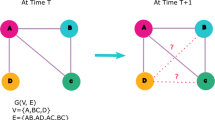Abstract
The link prediction problem has received extensive attention in fields such as sociology, anthropology, information science, and computer science. In many practical applications, we only need to predict the potential links between the vertices of interest, instead of predicting all of the links in a complex network. In this paper, we propose a fast similarity based approach for predicting the links related to a given node. We construct a path set connected to the given node by a random walk. The similarity score is computed within a small sub-graph formed by the path set connected to the given node, which significantly reduces the computation time. By choosing the appropriate number of sampled paths, we can restrict the error of the estimated similarities within a given threshold. Our experimental results on a number of real networks indicate that the algorithm proposed in this paper can obtain accurate results in less time than existing methods.





Similar content being viewed by others
References
Lü LY, Zhou T (2011) Link prediction in complex networks: A survey. Phys A 390:11501170
Kaya B, Poyraz M (2015) Age-series based link prediction in evolving disease networks. Comput Biol Med 63:1–10
Bao ZF, Zeng Y, Tay YC (2013) sonLP: social network link prediction by principal component regression. Proceedings of the 2013 IEEE/ACM International Conference on Advances in Social Networks Analysis and Mining: 364–371
Papadimitriou A, Symeonidis P, Yannis M (2012) Fast and accurate link prediction in social networking systems. J Syst Softw 85(9):2119–2132
Fournet J, Barrat A (2014) Contact patterns among high school students. PLoS ONE 9(9):e107878
Buccafurri F, Lax G, Nocera A, Ursino D (2015) Discovering missing me edges across social networks. Inf Sci 319:18–37
Jahanbakhs HK, King V, Shoja GC (2012) Predicting missing contacts in mobile social networks. Pervasive Mob Comput 8(5):698–716
Ibrahim NMA, Chen L (2015) Link prediction in dynamic social networks by integrating different types of information. Appl Intell 42(4):738–750
Xie F, Chen Z, Shang JX, Feng XP, Li J (2015) Alinkprediction approach for item recommendation with complex number. Knowl-Based Syst 81:148–158
Vidmer A, Zeng A, Medo M, Zhang YC (2015) Prediction in complex systems: The case of the international trade network. Phys A: Stat Mech Appl 436:188–199
Li X, Chen HC (2013) Recommendation as link prediction in bipartite graphs: A graph kernel-based machine learning approach. Decis Support Syst 54(2):880–890
Huang Z, Lin DKJ (2009) The time-series link prediction problem with applications in communication surveillance. INFORMS J Comput 21:286303
Liu HK, Lü L Y (2011) Uncovering the network evolution mechanism by link prediction (in Chinese). Sci Sin Phys Mech Astron 41:816823
Vapnik VN, Chervonenkis AY (1971) On the uniform convergence of relative frequencies of events to their probabilities. Theory Probab 16(2):264280
Vapnik V (1995) The Nature of Statistical Learning Theory
Haussler D (1992) Decision theoretic generalizations of the PAC model for neural net and other learning applications. Inf Comput 100:78–150
Maass W (1995) Vapnik-Chervonenkis dimension of neural nets. The Handbook of Brain Theory and Neural Networks:1000– 1003
Anthony M, Bartlett PL (1999) Neural network learning: theoretical foundations. Cambridge University Press, Cambridge
Munaro A (2016) The VC-dimension of graphs with respect to k-connected Subgraphs. Discret Appl Math 211:163174
Riondato M (2014) Sampling-based data mining algorithms: modern techniques and case studies. ECML PKDD 8726:516519
Sariel HP, Sharir M (2011) Relative (p)-approximations in geometry. Discret Comput Geom 45:462496
Hoffman M, Steinley D, Brusco MJ (2015) A note on using the adjusted Rand index for linkprediction in networks. Soc Netw 42:72–79
Aiello LM, Barrat A, Schifanell AR (2012) Friendship prediction and homophily in social media. ACM Trans Web (TWEB) 6(2):1–33
Gao S, Denoyer L, Gallinari P (2012) Probabilistic latent tensor factorization model for link pattern prediction in multi-relational networks. J China Univ Posts Telecommun 19:172–181
Lü L, Jin CH, Zhou T (2009) Similarity index based on local paths for link prediction of complex networks. Phys Rev E - Stat, Nonlinear Soft Matter Phys 80(4):046122
Liu WP, Lü L (2010) Link Prediction Based on Local Random Walk. Eur Phys Lett 89(5):58007
Wang XJ, Zhang X, Zhao CL, Xie Z (2015) Predicting link directions using local directed path. Phys A: Stat Mech Appl 419:260–267
Pujari M, Kanawati R (2012) Supervised Rank Aggregation Approach for Link Prediction in Complex Networks. WWW 2012 Companion:1189–1196
Zeng ZZ, Chen KJ, Zhang S, Zhang H (2013) A link prediction approach using semi-supervised learning in dynamic networks. Proceedings of Sixth International Conference on Advanced Computational Intelligence (ICACI):276280
He YL, Liu JNK, Hu Y, Wang X (2015) OWA operator based link prediction ensemble for social network. Expert Syst Appl 42(1):2150
Popescul A, Ungar L (2003) Statistical relational learning for link prediction. Proc Int Workshop Learn Stat Models Relational Data 149:172–179
Hanneke S, Fu WJ, Xing EP (2010) Discrete temporal models of social Networks. Electron J Stat 4:585605
Gao S, Denoye RL, Gallinari P (2011) Temporal Link Prediction by Integrating Content and Structure Information. Proc CIKM’ 11:1169–1174
Hu FY, Wong HS (2013) Labelling of human motion based on CBGA and probabilistic model. Int J Smart Sens Intell Syst 6(2):583–609
Li Y, Long PM (2001) Improved bounds on the sample complexity of learning. J Comput Syst Sci 62 (1):516–527
Author information
Authors and Affiliations
Corresponding author
Ethics declarations
Conflict of interests
The authors declare no conflicts of interest.
Funding
This research was supported in part by the Chinese National Natural Science Foundation under grant Nos. 61379066, 61070047, 61379064, 61472344, and 61402395;theNatural Science Foundation of Jiangsu Province under contracts BK20130452, BK2012672, BK2012128, and BK20140492;the Natural Science Foundation of the Education Department of Jiangsu Province under contracts 12KJB520019, 13KJB520026, and 09KJB20013;and the Six Talent Peaks Project in Jiangsu Province(Grant No. 2011-DZXX-032).
Rights and permissions
About this article
Cite this article
Dai, C., Chen, L. & Li, B. Link prediction based on sampling in complex networks. Appl Intell 47, 1–12 (2017). https://doi.org/10.1007/s10489-016-0872-1
Published:
Issue Date:
DOI: https://doi.org/10.1007/s10489-016-0872-1




